
.
.
|
Episode
1.
|
9th
May 1970
|
5:15
p.m.
|
23.21
|
5.7
|
72
|
|
Episode
2.
|
16th
May 1970
|
5:16
p.m.
|
22.04
|
5.9
|
66
|
|
Episode
3.
|
23rd
May 1970
|
5:16
p.m.
|
24.34
|
4.8
|
85
|
|
Episode
4.
|
30th
May 1970
|
5:16
p.m.
|
24.57
|
6.0
|
54
|
|
Episode
5.
|
6th
June1970
|
5:16
p.m.
|
23.42
|
5.4
|
54
|
|
Episode
6.
|
13th
June 1970
|
5:26
p.m.
|
23.32
|
5.7
|
73
|
|
Episode
7.
|
20th
June 1970
|
5:15
p.m.
|
24.33
|
5.5
|
79
|
.
A
crisis develops on a top secret drilling project - Inferno - which aims
to penetrate the Earth's crust and releases a new energy source to be
called Stahlman's Gas, named after Professor Stahlman, in charge of Inferno.
The drilling pipes are leaking a green liquid which, on contact with Human
Skin, transforms its victims into vicious primeval ape like creatures
called Primords. The Doctor is transported by accident into a parallel
world, where England is ruled by a military dictatorship and Inferno
is about to destroy the planet. Thwarted by his friend's counterparts
on this parallel world, the Doctor is powerless to stop the destruction
of the planet but manages to escape and return to Earth. There, he overcomes
the power crazed Professor Stahlman, who becomes Primord and threatens
to unleash the full forces of the Earth's core. Inferno is stopped in
time and Earth is saved.
.
.
![]()
The Doctor: Jon
Pertwee
Dr. Liz Shaw: Caroline
John
Brig. Lethbridge-Stewart: Nicholas
Courtney
Sergeant Benton: John Levene
Guest Appearances:
Prof. Stahlman: Olaf
Pooley
Sir Gold:Christopher
Benjamin
Bromley: Ian
Fairbairn
Slocum: Walter
Randall
Petra Williams: Shelia
Dunn
Greg Sutton: Derek
Newark
Latimer: David
Simeon
Wyatt: Derek
Ware
Sentry: Roy
Scammell
Patterson: Keith
James
Primords: Dave Carter, Pat Gorman,
Philip Ryan, Peter Thompson, Walter Henry
.
![]()
Producer:
Barry Letts.
Script Editor: Terrence
Dicks.
Assistant Editor:
Robin Squire (uncredited)
Writer:
Don Houghton
Director: Douglas Camfield, Barry Letts
(episodes 3-7).
Designer: Jeremy
Davies.
Costume: Christine
Rawlins.
Make up: Marion Richards.
Visual Effects: Len
Hutton.
Music : Stock.
.
![]()
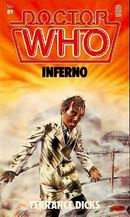 Novelised
as "Doctor Who - Inferno" by
Terrence Dicks (0 426 19617 1) first published by W.H. Allen
(now Virgin Publishing Ltd.) in 1984 with cover by Nick Spender.
Target library number 89.
Novelised
as "Doctor Who - Inferno" by
Terrence Dicks (0 426 19617 1) first published by W.H. Allen
(now Virgin Publishing Ltd.) in 1984 with cover by Nick Spender.
Target library number 89.
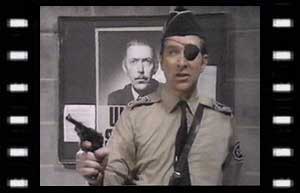
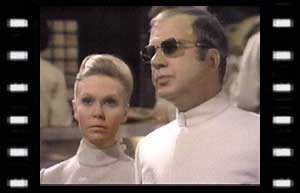

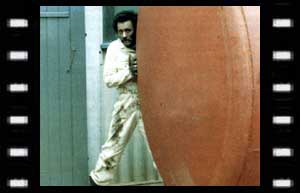
.
![]()
a
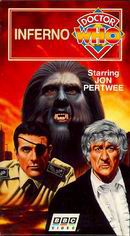

Released as "Inferno"
May 1994 in the UK
and Australia & New Zealand (BBC catalogue #5269); US & Canada
release 1995 (CBS/FOX catalogue #8292, reclassified as WHV #E1298). Cover
art by Colin Howard. Episode 7 was also released on "The Pertwee
Years" (BBC catalogue #4756 in the UK in March 1992, Australia
& New Zealand, CBS/FOX catalogue #5732 in US & Canada (1992).
.
![]()
.
![]()
This was
the last story to feature the original TARDIS console, as introduced in
1963.
After original director Douglas Camfield had a reaction to new heart medication,
Barry Letts directed the studio work for episodes 3-7 (uncredited).
The video release included an extra scene cut from the original UK transmission,
with Pertwee impersonating the voice of Lord Haw Haw the radio announcer,
it was felt that viewers at the time would recognize Pertwee's voice.
![]()
All seven episodes exist as both 16mm black & white telerecordings, as recovered from BBC Enterprises in 1978, and PAL conversions of NTSC 2" color videotape as recovered from TV Ontario in Canada in 1985.
![]()
Ealing
filming on Stage 2. (6-8
April 1970)
Studio
recording in TC3. (23-24 April; 6-8, 29 May 1970)
Studio
recording in TC6. (21-22 May 1970)
Berry
Wiggins and Co Ltd, Hoo St. Werburgh, Kent. (31March,
1-3April 1970)
![]()
Episode
1 - A rather stylish quick cut, from Harry
Slocum about to smash a technician's head in with a wrench to Benton hammering
a nail into a wall, is unfortunately marred when the wall wobbles noticeably
under Benton's hammer-strokes.
Episode
1-7 - This is a general problem
throughout the story: Bessie's wheels are completely clean and dry inside
the Doctor's hut, whereas the ground outside is clearly wet and muddy.
Episode
1 - Look at the "Nuclear
Power Output" gauge in the TARDIS laboratory: "megavolts"
is mis-spelt as "Megga Volts".
Episode
2 - The first person to be turned
into a monster by the primeval ooze is supposed to be red-hot (as are
they all) – in fact, when he dies lying against a wall, the paint is blistered
and burnt by the heat from his body. Yet his clothes remain completely
undamaged, not even slightly bursting into flame!
Episode
3 - Section Leader Elizabeth Shaw's
wig changes noticeably between the exterior and interior scenes.
Episode
3 - During one particular scene
in the alternate universe, Professor Stahlman calls Lethbridge-Stewart
"Brigadier" instead of "Brigade Leader".
Episode
3 - As the Doctor escapes from
the Brigade Leader's office, he runs past one of the control consoles,
which is complete with that extra little orange-coloured panel that was
used in episodes 1 and 2 to control the flow of power to the Doctor's
experiments. What's this thing doing in the parallel universe, since the
Doctor doesn't exist there?
Episode
3-5 - Jon Pertwee repeatedly mispronounces
"continuum" as "continny-um".
Episode
6 - At the end of this episode,
the Doctor's floppy bow tie is untied – but when he rematerialises in
our dimension, his tie is tied!
Episode
7 - The Earth's crust is on average
25 miles thick, and the drilling went on for roughly 60 hours (we see
the countdown timer in episode 1). Since the countdown was halted with
35 seconds to go, if we assume a constant drilling rate, that means the
drill would have been about 20 feet from breaking through to the Earth's
mantle when it was stopped. The problem is – shouldn't the huge pressures
which exist in the mantle break through that scant few feet of rock by
itself and cause the destruction of the Earth regardless?
.
